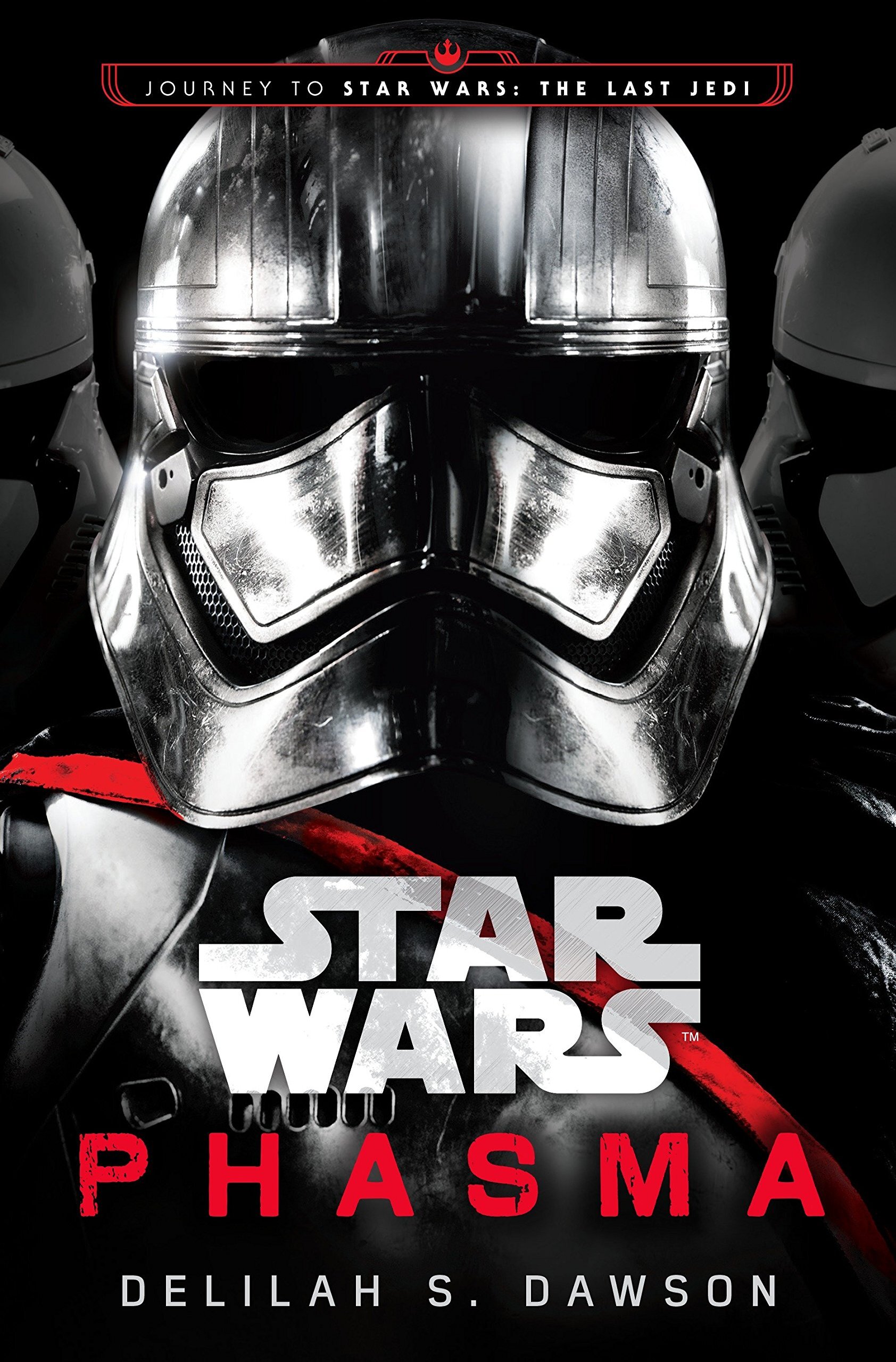By: Christian Corah
Descriptives
Page count: Kindle edition, 400 pages
Author: Delilah S. Dawson
Intended Audience: Adult
Timeline: Follows Return of the Jedi, precedes The Force Awakens
Main characters: Captain Phasma, Captain Cardinal, Vi Moradi, Siv, General Hux, and others.
Brief synopsis: Obsessed with learning more about Captain Phasma, Captain Cardinal forces Vi Moradi to tell the story of Phasma’s primitive life before joining the First Order.
Gut Feeling
I really didn’t expect to enjoy this book as much as I did. I hadn’t heard many good things about it (although I did hear some good things) and it doesn’t have a high score on Goodreads (3.76). Also, Phasma is pretty underhwelming in the Sequel Trilogy. She is essentially Boba Fett 2.0: looks really cool and doesn’t do anything. However, this book quickly grabbed my attention. Even though I am currently rather busy with school, work, and my book coming out later this year, I devoted a LOT of time to reading this book and finished it quite a bit faster than I expected. It turned Phasma into a ruthless and cunning villain: willing to do whatever it takes to succeed. This was a great book, but it didn’t always feel like a Star Wars story. This can be refreshing for some readers, but it isn’t what every Star Wars reader is looking for. But I’ll get into that later.
Before getting into the details, I will say this though. The book contains a considerable amount of torture and violence and I understand that not everyone will be comfortable with that. So keep that in mind while reading this review.
Characters (9/10 pts)
This was in no means a character led novel. It was the exciting plot and high stakes that made this book excel. Dawson did not devote much of the time to character development. However, that doesn’t mean that it won’t score well for this section. She did a lot with a little work. The characters were surprisingly well developed and relatable. And my emotional attachments to characters came from characters that I didn’t expect. Phasma came from a broken part of the planet Parnassos. There, she lived with a small tribe called the Scyre and trained a group of highly skilled warriors. Among the group were Siv and Torben. This is where Dawson was able to pull at my heart strings. Because this book is about Phasma, who is a villain, the book didn’t inherently have likeable characters. Phasma is fascinating, but I didn’t really root for her character. This isn’t a bad thing though. She is a villain and a great one at that. But Siv and Torben added a new element to the book because I was worried about what was going to happen to them. This greatly improves the score for this section.
But this doesn’t mean that Dawson did a poor job with Phasma’s character. It is quite the opposite. She is at her best in this book and it isn’t even close. In the movies, there aren’t really any characters that I despise. In Game of Thrones, we easily despise Joffrey and Ramsay Bolton, but Star Wars is lacking in this category. Yes, we hate Palpatine, Thrawn (especially in Rebels), and others, but there aren’t villains that do things that are truly shocking. Phasma, while not as extreme as Joffrey or Ramsay, falls into this category. She is truly one of the best villains in Star Wars and I wish the movies actually came close to portraying that.
This section is getting rather long, but I must dicuss the other main characters: Captain Cardinal and Vi Moradi. Moradi is a Resistance spy who tells the story of Phasma to Cardinal. Their arc is not as pronounced as Phasma’s, but it is still important. Cardinal was especially intersting. He was clearly the villain, but there was something about him that made him relatable. I won’t go into details to avoid spoilers, but it was interesting to have a villain who I wanted to root for.
Obviously, there is a lot going on regarding characters in the book and Dawson did a great job with them. All characters were unique from each others, had their own strengths, great development, and I was never confusing characters for each other. For these reasons, I am giving 9 points.
Writing Style (8.25/10) pts)
This is the first book that I’ve read by Dawson and I’m already a fan of her work. She has a balanced writing style between being easy to read and detailed. It never felt too simple or bogged down in details. It was consistent all the way through. Overall, the best strength of the writing style is that there’s no clear weaknesses. However, there really isn’t a clear strength that I can point to either. But it still felt slighly above the average Star Wars novel. I am giving 8.25 points.
Plot (9/10 pts)
This book is certainly led by the plot and the plot for Phasma is rather unique. It follows two different stories. The first follows Vi Moradi and Captain Cardinal, where Moradi tells Cardinal the story of Phasma, which is the second story. At the end, the story lines connect. In this way, it felt similar to the plot of Dooku: Jedi Lost. This plot design has one major advantage. It really keeps the story fresh as it bounces back and forth. As soon as one story might start to get dull (which it didn’t really), it would switch up and stay exciting.
It is fairly normal when a book has two separate story lines for one to be superior over the other. In this case, Phasma’s story was more exciting and made up most of the book. This should be the case, as the book is literally named for her. Her story was full of exciting moment after exciting moment. It was also high stakes for most of the moments, which made the peaks in the story that much more exciting. Even though I essentially knew what would happen for Phasma, I didn’t know the future for the other new characters in the story. This was really important for keeping the plot interesting. Dawson also didn’t pull ANY punches with the story. Shocking events happen and I was HERE FOR IT. My only critique of Phasma’s story is that there were too many peaks and not enough valleys. It jumped from one big event to another and didn’t always allow time for the plot to breathe inbetween.
Even though Phasma’s story was the best of the two, it doesn’t mean that the story of Moradi and Cardinal was not quality. It was often high stakes and compelling and served as a climatic finish to the book. The chapters also allowed Phasma’s story to breathe a little, which did help. Overall the plot was awesome and receives a score of 9 points.
Intrigue (9.5/10 pts)
Intrigue will be the highest scoring section for Phasma and it is mostly because of the plot. I talked about it in the previous section a lot, so I won’t be too repetive here. But most of the events in the plot were high stakes, and this happened basically from the first chapter of the book. These moments really grip the reader because they want to know what is going to happen next. I also really cared about what was going to happen to new characters and didn’t know what their fate would be. Because Dawson holds literally no punches in her storytelling, I never knew what was going to happen next. Also, because the story jumped around so much it always felt fresh. There were hardly any dull moments.The writing syle was also easy to read, which always adds to the intrigue. This all caused me to read this book very quickly (for my standards). I am giving 9.5 points.
What does it add? (6/10 pts)
We’ve had a lot of really great scores so far and this section will certainly not look like the others. It is the book’s greatest weakness: it doesn’t really add anything to the Star Wars universe. Yes, it does get fantastic development for an underused villain in the movies, but that doesn’t really have signifiance for anyone other than Phasma. And it certainly doesn’t matter for any time periods outside of the Sequel Trilogy. This book was written for one purpose: to provide a backstory for Phasma. It did that great, but not much else (although it does create new characters that are explored in Black Spre, also by Dawson, which I am reading now). For much of the story, it didn’t even seem like I was reading a Star Wars novel. It seemed to be from a whole new world. This can be refreshing for Star Wars fans wanting something new (similar to the feel of Thrawn Ascendancy), or it can turn away others. The only thing I can think of, beyond Phasma’s character, is this book provides an interesting new planet with a diverse set of cultures. This is interesting, but not really impactful to Star Wars as a whole. I am only giving 6 points for this section, but that shouldn’t deter you from reading this book. It is a great story, it just doesn’t really add anything to Star Wars lore.
Logic (0 pts)
There is nothing in Phamsa that added to or took away from the logic within the Star Wars universe. So, I am neither adding or taking away extra points.
Final Thoughts
My final score for Phamsa is an 8.35/10, or a B. This scores slightly above average for all books I’ve reviewed. It is actually tied with Leia, Princess of Alderaan by Claudia Gray, so that should tell you that this is a quality book. It was a great story that even non Star War fans can enjoy. I don’t think it is talked about enough and may be one of the more underrated Star Wars novels. However, as the scores show, it didn’t really add anything to Star Wars lore. So if you want a great story, or enjoy Phasma’s character, read this book. If you want new Star Wars lore, or don’t enjoy graphic or torture scens, there are others you can read.
I hope you enjoyed this book review and if there is a book that you want me to read or review, please let me know at christiancorah@gmail.com. As for now, I will only be doing Canon books (but in the future that might change).



